Designers Who Should Be Spanked: Kohler
Kohler plumbing products may look good, but, in my experience, their designs
are fundamentally flawed. Consider this drain assembly that has more flaws
than parts. It also happens to have more parts than it should!
Kohler Drain Design Flaws
Problem One: All Kohler drains for the 2600-series sinks have
holes in the drain flange assembly to permit connection of the
overflow and stopper mechanism. The 2600-series sinks don't have
overflows, and stoppers are optional. Rather than selling a
version of the drain flange that doesn't have those unecessary
holes, Kohler includes a kit that crudely blocks those
holes. |
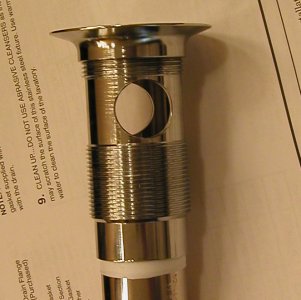 |
Problem Two: The Kohler kit to cover the unwanted holes uses a
2-inch length of PVC. According to my contractor, the building
code in my area forbids the use of PVC in drain assemblies. Kohler
provides no alternative. |
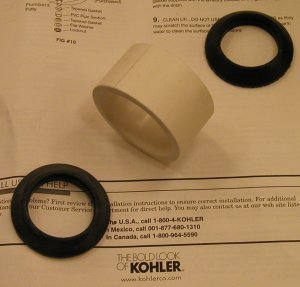 |
Problem Three: The kit makes it very difficult to clamp the
drain flange tightly to the sink basin. Getting the rubber
flanges into position while maintaining proper position of the
drain flange in the sink is quite the juggling act. |
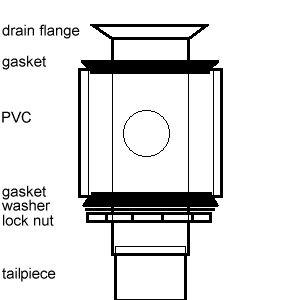 |
Problem Four: The kit creates little pockets of standing water
in the PVC sleeve as well as air pockets that interfere with the
smooth flow of water out of the drain. |
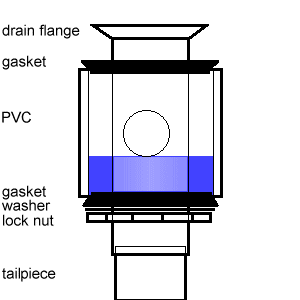 |
Problem Five: The drain flange and tailpiece are two distinct
pieces that come preassembled. Thus they look like a single
piece. The joint, which is not mentioned in the documentation,
is another possible point of failure. Teflon tape should have
been used in the joint to reduce the possibility of
leaking. |
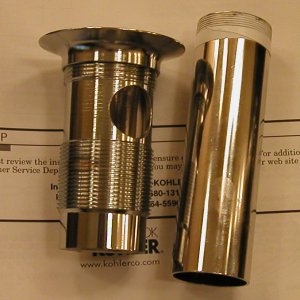 |
Problem Six: The drain flange should nest inside the
tailpiece, not the other way around. Water flows down, so
arranging these pieces correctly would avoid leakage. |
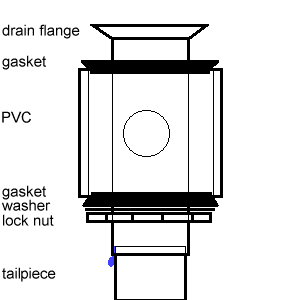 |
Problem Seven: Even with two wraps of Teflon tape, the joint
leaks. |
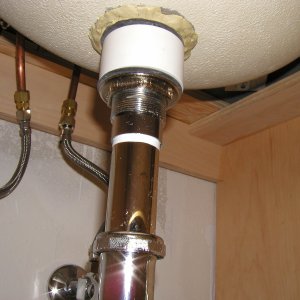 |
Problem Eight: The openings in the grill over the drain are
too fine, causing the water to create surface tension barriers
that impede the flow of water out of the basin and the release of
air trapped in the tailpiece. |
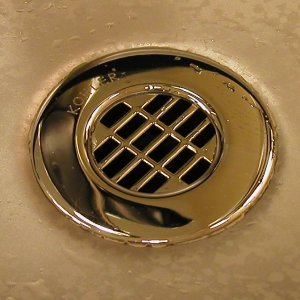 |
Results: With a well-designed drain, our sinks can drain nearly as fast
as the faucet can deliver the water. With the Kohler assembly, it takes 65
seconds to drain the amount of water delivered by the faucet in 10 seconds.
(This is an apples-to-apples comparison with the same faucet, sink, and
P-trap. The only difference is the drain flange assembly.) Furthermore,
the Kohler assembly leaks through the pre-assembled threaded joint, despite
two wraps of Teflon tape. (The leak occurred with two different brand-new
Kohler assemblies.)
The workaround solutions are illustrated here. Install the
Kohler drain after inspections so you don't get cited for using
PVC in a drain assembly. Drill a tiny hole high in the PVC
sleeve to allow the trapped air to escape and solve the flow
problem. I used a 5/32" bit. It's important that the air
release hole be high on the PVC. If it's too low, the
standing water that collects in the sleeve would seep through.
If the drain ever backs up, water will leak through the hole,
but it's a very small hole so it'll be a small mess. Stop the
leak with a more liberal application of Teflon tape. |
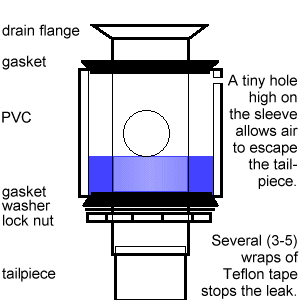 |
There are several things Kohler could have done to make this a better
product. First of all, they could have tested the design of the PVC kit. I
can't imagine that the flow problem could have been missed even by the most
casual of tests.
The flow problem could have been solved by offering a drain assembly that
doesn't have the unneeded holes (they do have them for other models of
lavatory basins, but not for our model). That design would then need to be
tested to make sure there isn't a flow problem. Perhaps a grill with
slightly larger openings would allow the air to escape straight up.
Failing that, they could have provided a vent piece that fits the overflow
hole rather than the PVC sleeve to cover them up. The vent would allow the
air to escape. It would also be simpler to clamp the assembly to the basin
without the impediment of the sleeve and extra gaskets. Either of these
approaches would have resulted in fewer parts (which may translate into less
manufacturing cost) and fewer potential problems (which reduces support
costs) and a better experience for the installer and end-user.
Ideally, the tailpiece would not have to be a separate part from the rest
of the drain assembly. Having a single piece would eliminate the possibility
of leaks, but I understand the possible manufacturing advantages of having a
separate tail piece. The separate piece is also easier to trim if necessary.
However, any company that deals with the flow of water should understand the
proper way to nest vertical pipes is to have the upper piece fit into the
lower piece. Failing that, they should have provided a tighter joint by
using a compression fitting. Failing that, Kohler should have sent the parts
unassembled. This would increase the chance that an experienced installer
would recognize the potential leak and apply Teflon tape to solve it. Failing
that, the installation guide should have suggested disassembling the pieces
to apply Teflon tape.
© 2002 Adrian McCarthy. All rights reserved.
Aidtopia and the author(s) of these pieces don't really condone spanking
designers. That phrase is meant in the figurative sense. If you really
want to help, lock the aforementioned designers into a room with a copy
of The Design of Everyday Things by Donald A. Norman
(ISBN: 0465067107). Last updated 1-NOV-2002.








